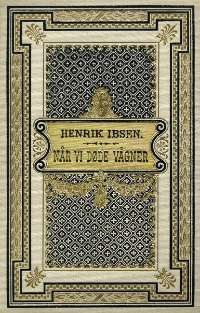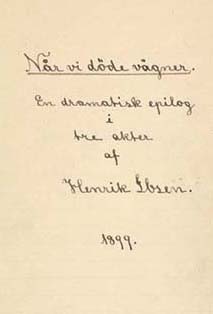

Brief description
When We Dead Awaken was the last play Ibsen wrote before he died. He wrote it in Christiania in 1899, and it is thought he began to plan it in the summer of 1897. In a letter dated 3 June 1897 to Georg Brandes, Ibsen wrote:
Can you guess what I am dreaming of and planning and picturing to myself as something so delightful? That’s settling down by Øresund, between Copenhagen and Elsinore, at a place with an open view, where I can see all the sea-going yachts coming and going on their long voyages. I can’t do that here. Here all the sounds are shut in, in every sense of the word, and every channel to understanding is stopped up. Oh, my dear Brandes, one is not unaffected by living abroad for 27 years in a free and liberating cultural climate. In here, or rather up here beside the fjords, is the country of my birth. But – but – but: where can I find my home country? The sea is what I am most drawn to. – – – Otherwise I go round here on my own, planning some sort of new drama. But I can’t see clearly yet what it’s going to be.
[read the letter in HISe]
The letter is interesting, not only because it indicates that a new play is being planned, but also because we recognize Ibsen himself in Arnold Rubek as we meet him in the opening scene of When We Dead Awaken, with both of them feeling homeless in their own country.
After John Gabriel Borkman (1896) three years passed instead of the usual two, before Ibsen published a new play. There were many factors that distracted Ibsen in his work with When We Dead Awaken. For one thing, he was unavoidably involved in planning the first two collected editions of his works: the German one, published in nine volumes by the historians of literature Julius Elias and Paul Schlenther in the years 1898–1903, and the Norwegian one, published by Danish Gyldendal in nine volumes from 1898 to 1900 (a supplementary volume was published in 1902).
In the spring of 1898 Ibsen celebrated his 70th birthday, with large-scale festivities held for him in Christiania, Copenhagen and Stockholm. He made speeches, gave interviews and received frequent visits in Christiania, so he did not get anything down in writing for When We Dead Awaken until the beginning of 1899. The first date was 20 February, 1899, and the first draft was begun two days later, with the title «The Day of Resurrection». The work still proceeded slowly, and it was not until the end of July that the first act was completed.
The title was changed during the writing of the fair copy, first to «When The Dead Awaken», and then to the final «When We Dead Awaken». The fair copy of the manuscript was sent to the publisher the same day as it was completed, 21 November 1899. The full title of the play, When We Dead Awaken. A Dramatic Epilogue in Three Acts, became known before the book was for sale. The Danish newspaper Politiken concluded from the word «epilogue» that «the writer has spoken his last words in this play and has thus concluded his dramatic works». But this was denied by Ibsen himself in an interview in the newspaper Verdens Gang on 12 December 1899.
No, that is an over-hasty conclusion. The term «epilogue» does not refer to any such thought on my part. Whether I come to write something more is another matter. What I meant by the term epilogue in this connection is simply that the play forms an epilogue to a number of my dramas, beginning with «A Doll’s House», and ending now with «When We Dead Awaken». The latter work comes under the experiences I have wanted to describe in these plays. They form a unity, a whole, and thus I have finished. If I come to write something more hereafter, it will all be in quite a different connection, and perhaps in a different form as well.
When We Dead Awaken was published by Gyldendalske Boghandels Forlag (F. Hegel & Søn) on 22 December 1899 in Copenhagen, Christiania, Stockholm and Berlin, and consisted of 12 000 copies. A second issue of 2 000 copies had to be printed even before the book was on sale (the same thing had happened on the publication of John Gabriel Borkman three years previously), on account of the large number of advance orders. Thus the first and second issues – 14 000 copies altogether – were released simultaneously.
As had been the case with the four previous plays, When We Dead Awaken was also published by William Heinemann in London in a «mini-edition» of 12 copies. This took place on 19 December 1899, three days before the Gyldendal edition.
A German edition of the play, in Christian Morgenstern’s translation, was published in Berlin later the same month. Shortly after that, English, French, Italian, Russian and Polish translations were published. The book was received with respect.
The first public performance of When We Dead Awaken was a reading at the Theatre Royal in the Haymarket, London, on 16 December 1899. This was a part of William Heinemann’s strategy in order to obtain the copyright to the play (see above).
The first full staging of the play was at the Hoftheater in Stuttgart on 26 January 1900, followed shortly afterwards by productions in Copenhagen, Helsingfors, Christiania, Stockholm and Berlin. It proved difficult to make the play function satisfactorily on the stage. Edvard Brandes wrote in connection with Det Kongelige Teater’s production the «The actors were too small».
(From ibsen.net)
Plot summary
Arnold Rubek is an ageing, celebrated sculptor who has achieved great international fame with his sculpture «The Day of the Resurrection». The model for this piece of sculpture was Irene, who earlier had considered it her lifework to accompany Rubek and help him in his work. They appear to have had strong feelings for each other at that time, but Rubek refused to consider Irene as anything more than his model, so, disappointed and angry, she left him. Since then, Rubek's creative power has diminished, and he now feels that he can no longer create art of any significance. Irene, alone, holds the key to his creativity. He has married Maja, a considerably younger woman, and the two of them have lived abroad in a marriage that has gradually become somewhat cool.
The play opens with Rubek and Maja staying at a seaside hotel in Norway. They meet Ulfheim, a landowner and bear-hunter, who invites Maja to get up into the mountains with him. One of the guests at the hotel is a mysterious woman dressed in white and accompanied by a nurse. This turns out to be Irene. She has been married twice, and has been in a mental hospital. She seems to be in the grip of a «living death», and in a painful confrontation she accuses Rubek of having ruined her life and stolen her soul. For his part he begs her to come back to him so that he can regain his creative power. The two of them go up into the mountains to become lovers again. Near the top they meet Maja and Ulfheim. A storm blows up, and Maja and Ulfheim go down the mountain into safety, while Irene and Rubek go on towards the peak, where they die in an avalanche.
(Source: Merete Morken Andersen, Ibsenhåndboken, Gyldendal Norsk Forlag, 1995.)
Read When We Dead Awaken (in Norwegian)
In the online version of the official Ibsen edition (HISe) you can read When We Dead Awaken in various formats. This content is currently only available in Norwegian. Follow the links below to read the play:
Introduction to the work (in Norwegian)
The online version of the official Ibsen edition (HISe) offers extensive information about When We Dead Awaken in Norwegian. Follow the links below to read about various aspects connected to the play.
- Background
- Creative process
- About the publication
- Stagings in Ibsen's life time
- Parodies in Ibsen's life time
- More information
Reviews
Here you can find reviews in full text and an overview of registered reviews in various languages.
- Reviews from Ibsen's life time in full text
- Reviews registered in the Ibsen bibliography (nb.no)
- Reviews registered in "Norsk litteraturkritikk" (UiO)
Translations
- The Multilingual Ibsen
- Translations in various languages
- Overview of translations from Ibsen's lifetime (HISe)